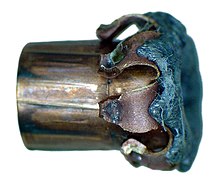
| Part of a series on |
| Forensic science |
|---|
 |
Forensic firearm examination is the forensic process of examining the characteristics of firearms or bullets left behind at a crime scene. Specialists in this field try to link bullets to weapons and weapons to individuals. They can raise and record obliterated serial numbers in an attempt to find the registered owner of a weapon and look for fingerprints on a weapon and cartridges.
By examining unique striations impressed into a bullet from the barrel of a gun, expended ammunition can be linked back to a specific weapon.[1] These striations are due to the rifling inside the barrels of firearms. Rifling spins the bullet when it is fired out of the barrel to improve precision.[2] Although bullet striations are individualized unique evidence, microscopic striations in the barrel of the weapon are subject to change slightly, after each round that is fired.[1] For this reason, forensic ballistics examiners may not fire more than five shots from a weapon found at a scene.[3] Known exemplars taken from a seized weapon can be compared to samples recovered from a scene using a comparison microscope as well as newer 3-D imaging technology. Striation images can also be uploaded to national databases. Furthermore, the markings can be compared to other images in an attempt to link one weapon to multiple crime scenes.
Like all forensic specialties, forensic firearm examiners are subject to being called to testify in court as expert witnesses. However, the reliability of some techniques of forensic firearm examination have been criticized.[4][5]
- ^ a b "Firearm Examiner Training". projects.nfstc.org. Retrieved 2022-04-09.
- ^ Heard, Brian (2013). Forensic Ballistics in Court: Interpretation and Presentation of Firearms Evidence. John Wiley & Sons. pp. 33–42. ISBN 9781118505014.
- ^ Heard, Brian (2013). Forensic Ballistics in Court: Interpretation and Presentation of Firearms Evidence. John Wiley & Sons. p. 41. ISBN 978-1-118-50501-4.
- ^ Kennedy, Donald (2003-12-05). "Forensic Science: Oxymoron?". Science. 302 (5651): 1625. doi:10.1126/science.302.5651.1625. ISSN 0036-8075. PMID 14657460.
- ^ Albright, David L. Faigman,Nicholas Scurich,Thomas D. "The Field of Firearms Forensics Is Flawed". Scientific American. Retrieved 2022-05-29.
{{cite web}}: CS1 maint: multiple names: authors list (link)